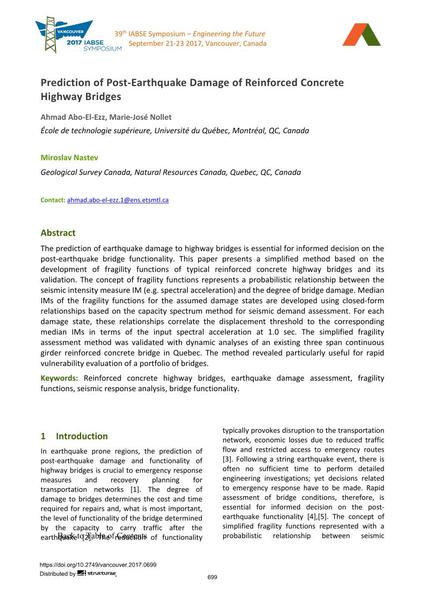Prediction of Post-Earthquake Damage of Reinforced Concrete Highway Bridges

|
|
|||||||||||
Bibliografische Angaben
| Autor(en): |
Ahmad Abo-El-Ezz
(École de technologie supérieure, Université du Québec, Montréal, QC, Canada)
Marie-José Nollet (École de technologie supérieure, Université du Québec, Montréal, QC, Canada) Miroslav Nastev (Geological Survey Canada, Natural Resources Canada, Quebec, QC, Canada) |
||||
|---|---|---|---|---|---|
| Medium: | Tagungsbeitrag | ||||
| Sprache(n): | Englisch | ||||
| Tagung: | IABSE Symposium: Engineering the Future, Vancouver, Canada, 21-23 September 2017 | ||||
| Veröffentlicht in: | IABSE Symposium Vancouver 2017 | ||||
|
|||||
| Seite(n): | 699-706 | ||||
| Anzahl der Seiten (im PDF): | 8 | ||||
| Jahr: | 2017 | ||||
| DOI: | 10.2749/vancouver.2017.0699 | ||||
| Abstrakt: |
The prediction of earthquake damage to highway bridges is essential for informed decision on the post-earthquake bridge functionality. This paper presents a simplified method based on the development of fragility functions of typical reinforced concrete highway bridges and its validation. The concept of fragility functions represents a probabilistic relationship between the seismic intensity measure IM (e.g. spectral acceleration) and the degree of bridge damage. Median IMs of the fragility functions for the assumed damage states are developed using closed-form relationships based on the capacity spectrum method for seismic demand assessment. For each damage state, these relationships correlate the displacement threshold to the corresponding median IMs in terms of the input spectral acceleration at 1.0 sec. The simplified fragility assessment method was validated with dynamic analyses of an existing three span continuous girder reinforced concrete bridge in Quebec. The method revealed particularly useful for rapid vulnerability evaluation of a portfolio of bridges. |
||||
